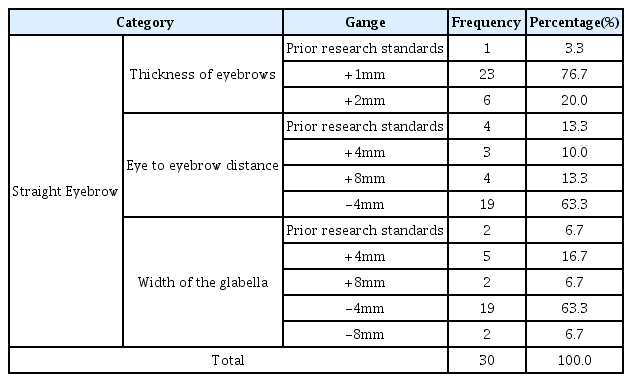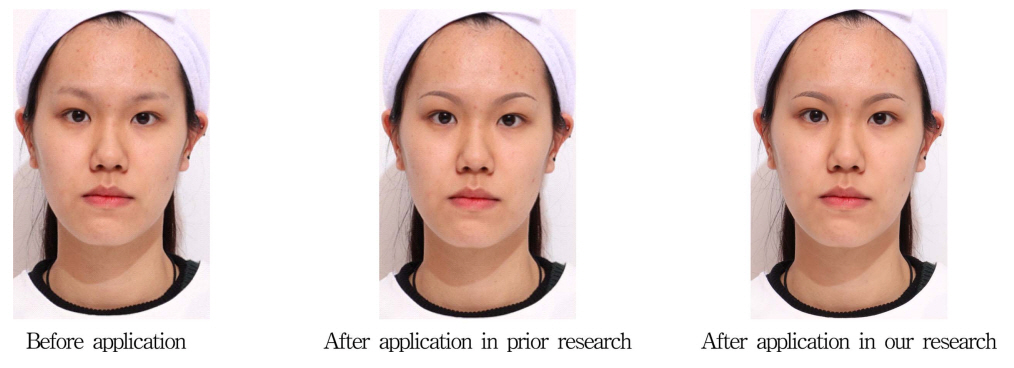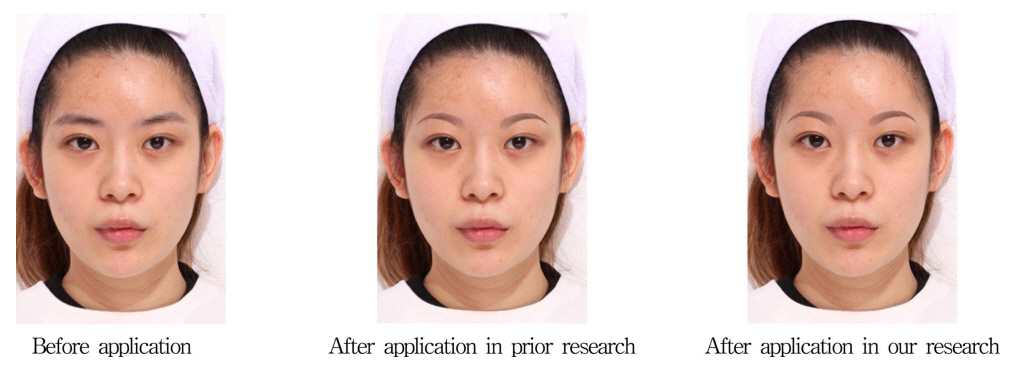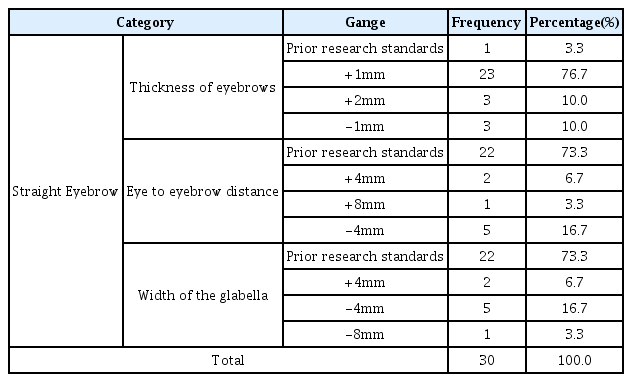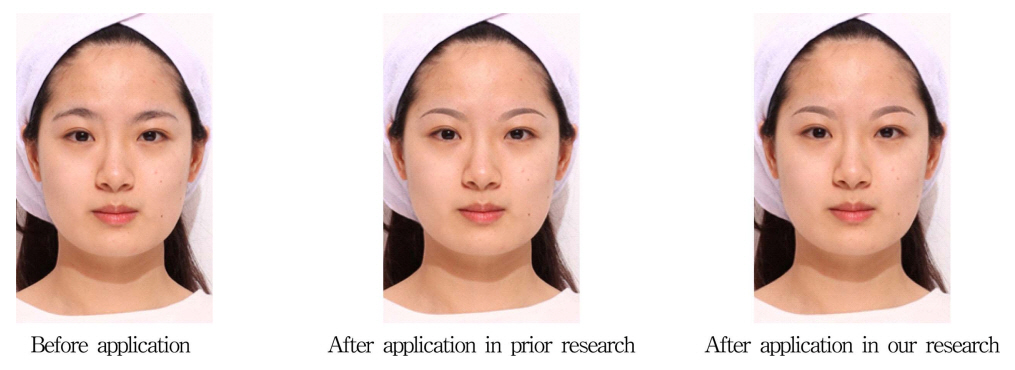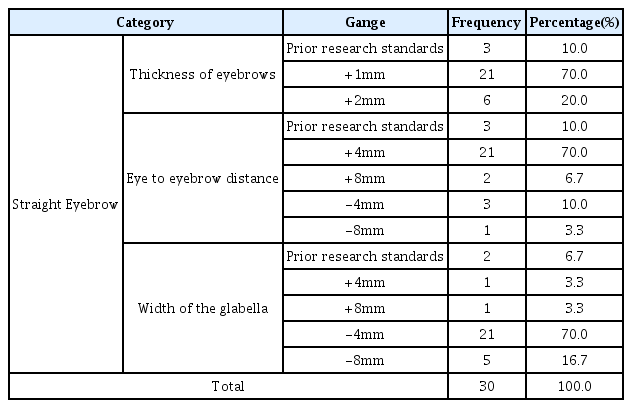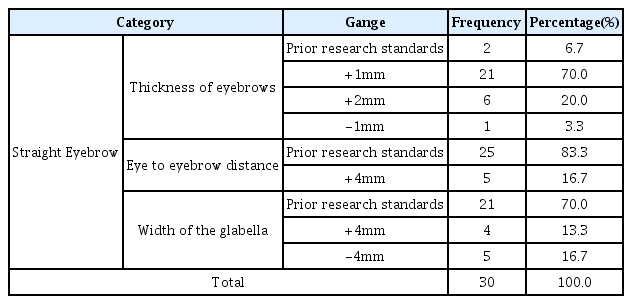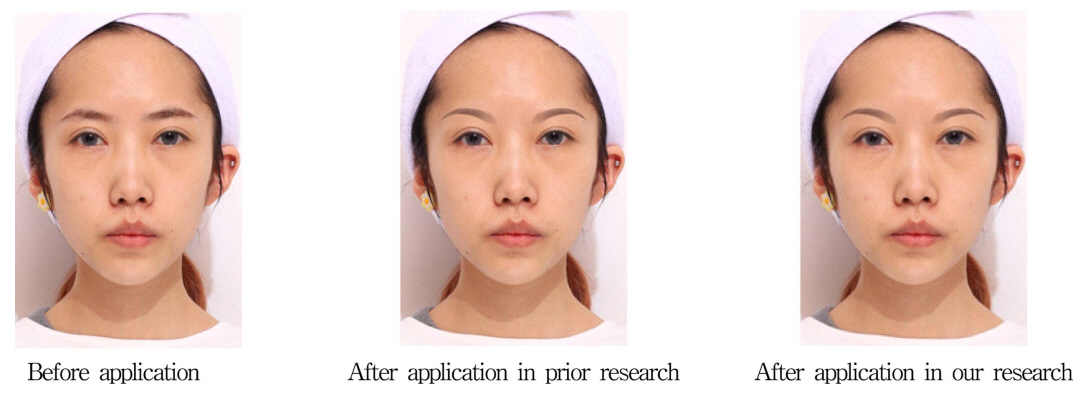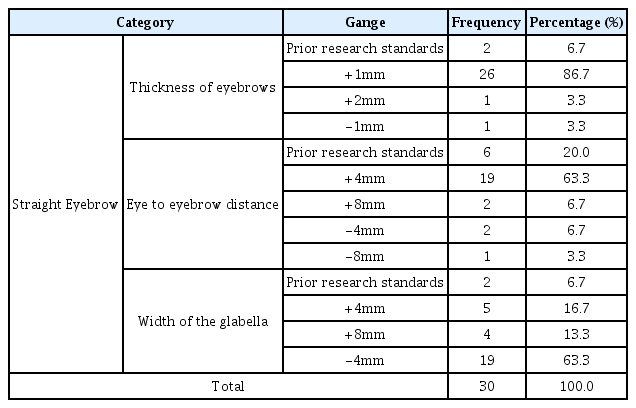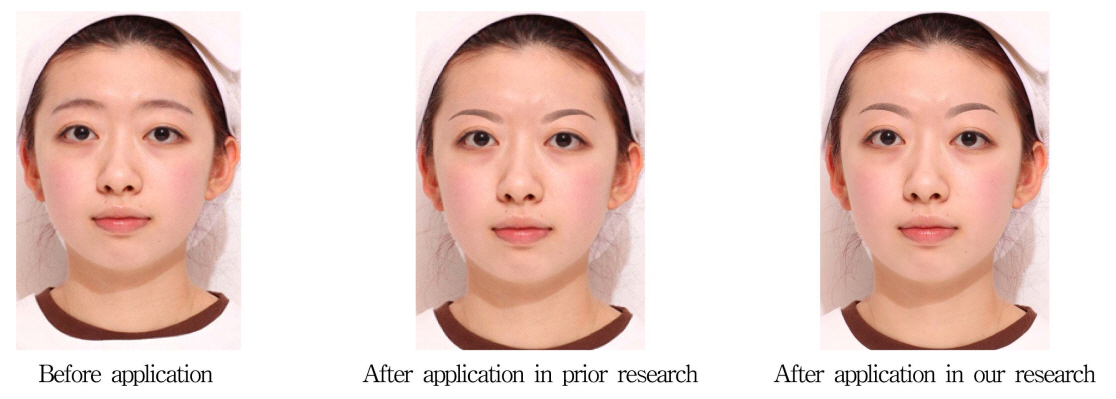AI 뷰티 서비스 개발을 위한 표준형 눈썹 디자인 연구
A Study on the Standard type of Eyebrow Design for the Development of A.I. Beauty Service
Article information
Trans Abstract
A little bit of change in eyebrow makeup, which is essential for complementing a face shape and regulating its image, can have an effect on an overall face; especially, mandatory mask wearing due to the covid-19 breakout has highlighted the importance of eyebrow makeup, creating a variety of eyebrow shapes. Among them, ‘standard’ eyebrow type goes well with all types of face shape. However, it does not mean eyebrow makeup can complement the disadvantages of face shape. Therefore, as concerns the thickness of eyebrow, the gap between eyebrows and eyes, and the glabellar width, this study aimed to collect their quantitative data on the base of which standard eyebrow type is corrected and supplemented enough to be suited well by face shape, in order to provide basic data for creating the algorithm of A.I.-based beauty device – a stepping stone for the development of related services. In this study, we made a literature review on standard eyebrow type, thus making an organised experiment, and then performed an expert evaluation of its result. The findings of this study were as follows: First, when we made standard eyebrow expressions on a long face by using makeup eyebrow pencil, expressing much narrower the gap between eyebrow and eye, and the glabellar as well turned out to be effective. This may be because such a makeup made the gap look relatively short, and the narrow-looking glabellar made the face center catch one’s eye, with the result that they helped the narrow face look relatively wide. Second, when we made standard eyebrow expressions on a diamond face, expressing the glabellar much narrower turned out to work. It can be because the narrow-looking glabellar made the face center catch one’s eye, keeping one's eyes out of high cheekbones. Third, when standard eyebrow was expressed on an angular or inverted triangle face, penciling the overall eyebrows much thicker made the face area look relatively narrower, had the desired effect. It may be worth meaning that such an eyebrow makeup made the exposed face area smaller, eclipsing the standout angular part of the face. Finally, when we made standard eyebrow expressions on a round or oval face, expressing the eyebrow much thicker, the gap between eye and eyebrow much wider, and the glabellar much narrower proved effective. It may be because the narrow-looking glabellar made one’s eye focused on the center of the face, helping look relatively narrow the wide midface which ranges from eyebrow to the tip of the nose from the aesthetic view.
I. 서 론
4차 산업혁명 시대가 도래하면서 다양한 기술적인 혁명들은 뷰티 산업에도 변화를 일으키고 있고 특히, 2019년 12월 시작된 코로나 19 이후에 비대면 방식이 늘어나면서 뷰티 서비스에도 영향을 미치고 있다(Paek, 2019). 사용자의 얼굴을 분석해주는 인공지능(AI) 매칭 기술 등을 통한 개별 맞춤형 가상 메이크업 서비스를 제공해주는 신개념 뷰티 디바이스(Beauty Device)가 출시되었고(Kim, 2018; Choi, 2021), 화장품 업계에서도 AR(Augmented Reality) 등의 디지털 기술을 결합한 ‘스마트 스토어’가 등장하기 시작하였다(Lee, 2018).
뷰티 어플리케이션(application)을 기반으로 하는 서비스인 ‘룩스(Looks)’는 뷰티 카메라 앱을 통해 다양한 뷰티 브랜드의 생생한 최신 가상 메이크업 효과를 실시간으로 셀피(selfie)에 적용하여 해당 제품을 직접 확인할 수 있다. ‘유캠 메이크업(YouCam Makeup)’은 얼굴에 화장품을 직접 사용하지 않고 메이크업을 한 모습을 볼 수 있으며(Kim, 2020), 화장과 관련된 다양한 정보를 제공하고 초기 화면의 메이크업 아이콘을 터치하면 카메라가 작동하여 세세한 가상 메이크업 테스트가 가능한 서비스를 제공하고 있다(Woo & Kim, 2020). ‘잼 페이스(Zam Face)’는 국내 최초 뷰티 영상 큐레이션 앱으로 ‘AI객체 인식’ 기술을 기반으로 뷰티 유튜버 영상을 메이크업 단계별로 제품 사용 구간에 따라 나눠서 볼 수 있는 ‘타임점프’ 서비스를 세계 최초로 선보였다. 로레알(L’OREAL)은 스마트 미러를 이용한 메이크업 ‘지니어스(Makeup Genius)’ 앱, 크리스찬디올(ChristianDior)의 가상 현실 헤드셋 ‘디올 아이(Dior Eye)’ 등 메이크업 분야에 인공지능을 접목한 서비스가 가속화되는 추세다(Choi, 2021).
최근 여성의 사회적 진출이 늘어남에 따라 외모에 관한 관심과 아름다움을 충족시키기 위한 노력은 계속되고 있으며 이미지를 중요시하는 현대사회에서 메이크업의 중요성이 점점 강조되고 있다(Jung, 2019). 메이크업은 크게 피부, 눈, 눈썹 그리고 입술의 부위별 영역으로 나눌 수 있으며(Song & Kim, 2021), 그중 눈썹화장은 얼굴형을 보완하고 이미지 조절에 가장 핵심적 부위이기 때문에 작은 변화에도 얼굴 전체에 영향을 미친다(Kim & Kang, 2014; Zhang & Choi, 2022). 특히 코로나 19 이후 마스크를 의무적으로 착용해야 하는 상황에서 눈썹화장이 더욱 중요해졌다(Zhang & Choi, 2021).
눈썹과 관련한 선행연구들을 살펴보면 눈썹 메이크업 형태에 관한 연구(Park, 2012; Cho & Park, 2013; Park, 2018; Park & Park, 2019; Park et al., 2022), 눈썹화장 변화에 관한 연구(Shin, 2010; Park, 2012; Kim, 2013; Park & Kim, 2017), 눈썹화장 선호도 및 인식도에 관한 연구(Jung, 2022; Zhang & Choi, 2021; Kim & Kim, 2022) 등이 있다. 이렇듯 눈썹의 다양한 형태와 얼굴형별로 어울리는 눈썹에 대한 여러 가지 선행연구가 있지만, 모든 얼굴형에 무난하게 잘 어울리는 일반적인 ‘표준형 눈썹’(Seo, 2015; Zhang & Choi, 2022)에 대해 잘 모르고 깊이 있는 연구는 부족하다. 무난하게 어울린다는 것은 모든 얼굴형에 표현할 수 있다는 의미이고, 얼굴의 단점을 충분히 보완할 수 있다는 의미는 아니다. 따라서 얼굴형을 수정하고 보완하려면 같은 표준형 눈썹이라도 눈썹의 두께와 위치에 차이가 있을 것으로 사료된다. 더욱이 일반인들은 표준형 눈썹에 대해 정확하게 인지하지 못하고 있다(Zhang & Choi, 2021)는 것을 고려할 때, 표준형 눈썹을 얼굴형에 따라 수정·보완할 수 있는 방법적인 제시가 뷰티 서비스 기능에 탑재된다면 메이크업이 얼굴의 단점을 보완하고 아름다운 부분을 돋보이도록 하는 목적(Back, 2013)을 더욱 효과적으로 수행할 수 있을 것이다. 이에 본 연구는 표준형 눈썹이 얼굴형에 따라 얼굴형을 수정·보완할 수 있도록 눈썹의 두께, 눈썹과 눈 사이 간격, 미간 너비의 수치화된 데이터를 도출하고자 한다. 본 연구를 통해 표준형 눈썹을 얼굴형에 따라 적용할 수 있는 데이터를 수집하여 인공지능을 기반으로 하는 뷰티 디바이스의 알고리즘 생성의 기초 자료를 제공하고, 관련 서비스 개발에 도움을 주어 미용 산업에 활용되기를 기대한다.
II. 내용 및 방법
1. 얼굴형별 실험 대상 선정 및 사진수집방법
얼굴형의 시각적 분류기준은 턱 끝 각, 이마 각, 얼굴 길이, 얼굴 폭, 턱결절간 직선거리, 얼굴 길이, 상안 길이, 하악간 폭등이다(Jeong, 2020). 길이가 발달한 얼굴은 긴형과 다이아몬드형, 폭이 발달한 얼굴은 각진형, 둥근형, 역삼각형 및 계란형 얼굴의 총 6가지로 분류한다(Seo, 2015; Jeong, 2020; Zhang & Choi, 2022).
긴형의 특징은 얼굴의 폭이 좁고, 이마와 턱이 발달하였으며, 길이가 길고 가는 얼굴 형태이다. 다이아몬드형의 특징은 이마와 양 턱이 좁고 광대뼈가 돌출된 긴 얼굴형에 속하는 형태이다. 각진형의 특징은 폭과 길이가 거의 비슷해 보이고, 헤어 라인과 볼 선이 직선적이며 이마가 넓고 발달한 사각의 턱 선과 전체적으로 얼굴이 네모난 형태이다. 둥근형의 특징은 가로 폭과 세로 길이가 거의 동일하고 얼굴 외곽선이 둥글고 살이 있는 형태이다. 역삼갹형의 특징은 이마가 넓고 턱 쪽으로 내려올수록 얼굴이 좁아지고 광태뼈가 발달한 형태이다. 계란형의 특징은 가로 폭보다 세로 길이가 약간 길고, 각이 없이 매끄럽게 곡선형으로 이루어져 있고, 중간 부분이 넓고 턱 부분 좁은 곡선 얼굴형의 특징을 가지고 있다(Kim et al., 2014; Tak & Kim, 2015; Cho & Yang, 2017; Song & Kim, 2021; Zhang & Choi, 2022), 이에 본 연구에서는 선행 연구의 얼굴형 분류를 기준으로 메이크업 분야에서 10년 이상 경력이 있는 다섯 명의 전문가가 육안 분석하여 긴형, 다이아몬드형, 각진형, 둥근형, 역삼각형, 계란형의 얼굴을 가진 20대 여성 6명을 실험 모델로 선정하였다. 20대로 한정한 이유는 이 시기가 사춘기를 지나 성인기가 되면서 얼굴의 형태가 완성되고 사회적, 생리적 요인에 의한 얼굴 형태의 변화가 적으며, 다른 연령대에 비해 비교적 정확한 얼굴의 형태를 유지하기 때문이다(Zhang & Choi, 2021; Zhang & Choi, 2022).
실험의 목적과 범위 및 활용을 설명하고, 개인정보 보호법 제15조에 의거한 개인정보의 수집·이용 목적, 수집하려는 개인정보의 항목, 개인정보의 보유 및 이용 기간을 명시하여 동의를 구한 후, 자필 서명을 받고 실험을 진행하였다.
얼굴형별 사진을 수집을 위하여 S대학교 연구실에서 실험 동의자들의 정면 사진을 촬영하였다. KSA3011의 태양광과 흡사한 5000K의 정확한 색온도를 내는 조명 기구를 설치하고, 자연광의 조도를 유지한 측정환경을 설정하여(Cha & Kim, 2011; Byun, 2019) 촬영하였다. 카메라는 디지털카메라 5D MARKⅢ (Canon, Tokyo, Japan), 카메라의 높이는 150cm, 피사체에서 카메라까지의 거리는 200cm, 셔터 스피드는 1/160, 감광도는 ISO 100, 조리개는 F16으로 하였다.
2. 실험 방법
표준형 눈썹과 관련된 선행연구 고찰을 통해 표준형의 눈썹 두께, 눈썹과 눈 사이 간격, 미간 너비를 정리하였다<Table 1>. 표준형 눈썹의 두께는 앞머리의 상·하 폭이 9.8mm였고, 눈썹과 눈 사이의 간격은 동공 중앙점에서 눈썹의 제일 높은 곳까지의 거리 22.05mm, 외안각에서 수직으로 눈썹의 상단까지의 거리 23.38mm, 위 눈꺼풀의 가장자리 중 제일 높은 점에서 위로 수직선을 그어서 눈썹 하부와 만나는 지점과의 거리 13.7mm, 내안각에서 수직으로 눈썹 상부까지의 거리 22.85mm였으며 미간 너비는 28.8mm였다(Park, 2006; Kim, 2008; Park & Park, 2019).
Adobe Photoshop 2020 프로그램을 이용하여 모니터 해상도 1440×900의 컴퓨터(MacBook Pro, China, Seoul, Repulic of Korea)로 선행연구에서 수집한 눈썹의 두께, 눈 사이 간격, 미간 너비의 수치를 얼굴형별로 적용하고, 거기에 1mm씩 수치를 조절하여 자극물을 제작하였다.
첫째, 선행연구 분석을 통해 도출한 수치대로 실제 얼굴 크기의 1:1 비율로 환원하여 눈썹을 표현하였다.
둘째, 눈썹의 두께를 ±1mm, ±2mm, ±3mm, ±4mm까지 조절하였다.
셋째, 눈썹과 눈 사이의 간격을 ±1mm, ±2mm, ±3mm, ±4mm, ±5mm, ±6mm, ±7mm, ±8mm까지 조절하였다.
넷째, 미간 너비를 ±1mm, ±2mm, ±3mm, ±4mm, ±5mm, ±6mm, ±7mm, ±8mm까지 조절하였다.
3. 평가 및 분석 방법
긴형, 다이아몬드형, 각진형, 둥근형, 역삼각형, 계란형 총 6가지 얼굴형에 공통적으로 어울리는 표준형 눈썹의 두께, 눈썹과 눈 사이 간격, 미간 너비에 대한 평가를 위해 항목별 평가지를 구성하여 메이크업 관련 전공 10년 이상의 경력자 30명이 자기 기입식 평가를 시행하였다.
얼굴형별로 어울리는 표준형 눈썹의 두께, 눈썹과 눈 사이 간격, 미간 너비 평가 항목은 12문항의 명목척도로 구성하였다 <Table 2>.
연구 분석은 SPSS 25.0 통계 프로그램을 사용하여 6가지 얼굴형별 공통적으로 어울리는 표준형 눈썹 디자인을 파악하기 위해 빈도분석(Frequency analysis)을 실시하였다.
III. 결과 및 고찰
1. 긴형 얼굴에 적합한 표준형 눈썹 수치
긴형 얼굴에 적합한 표준형 눈썹의 수치를 파악하기 위해 빈도분석을 한 결과는 다음과 같다<Table 3>.
두께는 +1mm가 23명(76.7%)으로 가장 높게 나타났고, 눈썹과 눈 사이 간격은 -4mm가 19명(63.3%)으로 가장 높았으며, 미간 너비는 -4mm가 19명(63.3%)으로 가장 높았다.
이상의 결과를 통해 수집한 수치를 눈썹의 두께, 눈썹과 눈 사이 간격, 미간 너비에 대입하여 정리하면, 눈썹 두께는 눈썹 앞머리의 상·하 폭 10.8mm였다. 눈썹과 눈 사이 간격은 동공 중앙점에서 눈썹의 제일 높은 곳까지의 거리 18.05mm, 외안각에서 수직으로 눈썹의 상단까지의 거리 19.38mm, 위 눈꺼풀의 가장자리 중 제일 높은 점에서 위로 수직선을 그어서 눈썹 하부와 만나는 지점과의 거리 9.7mm, 내안각에서 수직으로 눈썹 상부까지의 거리 18.85mm였다. 미간 너비는 24.8mm였다<Table 4>, <Fig. 1>.
2. 다이아몬드형 얼굴에 적합한 표준형 눈썹 디자인
다이아몬드형 얼굴에 적합한 표준형 눈썹의 수치를 파악하기 위해 빈도분석을 한 결과는 다음과 같다<Table 5>.
두께는 +1mm가 20명(66.7%)으로 가장 높게 나타났고, 눈썹과 눈 사이 간격은 선행연구 기준이 23명(76.7%)으로 가장 높았으며, 미간 너비는 -4mm가 18명(60.0%)으로 가장 높았다.
이상의 결과를 통해 수집한 수치를 눈썹의 두께, 눈썹과 눈 사이 간격, 미간 너비에 대입하여 정리하면, 눈썹 두께는 눈썹 앞머리의 상·하 폭 10.8mm였다. 눈썹과 눈 사이 간격은 동공 중앙점에서 눈썹의 제일 높은 곳까지의 거리 22.05mm, 외안각에서 수직으로 눈썹의 상단까지의 거리 23.38mm, 위 눈꺼풀의 가장자리 중 제일 높은 점에서 위로 수직선을 그어서 눈썹 하부와 만나는 지점과의 거리 13.7mm, 내안각에서 수직으로 눈썹 상부까지의 거리 22.85mm였다. 미간 너비는 24.8mm였다<Table 6>, <Fig. 2>.
3. 각진형 얼굴에 적합한 표준형 눈썹 디자인
각진형 얼굴에 적합한 표준형 눈썹의 수치를 파악하기 위해 빈도분석을 한 결과는 다음과 같다<Table 7>.
두께는 +1mm가 23명(76.7%)으로 가장 높게 나타났고, 눈썹과 눈 사이 간격은 선행연구 기준이 22명(73.3%)으로 가장 높았으며, 미간 너비는 선행연구 기준이 22명(73.3%)으로 가장 높았다.
이상의 결과를 통해 수집한 수치를 눈썹의 두께, 눈썹과 눈 사이 간격, 미간 너비에 대입하여 정리하면, 눈썹 두께는 눈썹 앞머리의 상·하 폭 10.8mm였다. 눈썹과 눈 사이 간격은 동공 중앙점에서 눈썹의 제일 높은 곳까지의 거리 22.05mm, 외안각에서 수직으로 눈썹의 상단까지의 거리 23.38mm, 위 눈꺼풀의 가장자리 중 제일 높은 점에서 위로 수직선을 그어서 눈썹 하부와 만나는 지점과의 거리 13.7mm, 내안각에서 수직으로 눈썹 상부까지의 거리 22.85mm였다. 미간 너비는 28.8mm였다<Table 8>, <Fig. 3>.
4. 둥근형 얼굴에 적합한 표준형 눈썹 디자인
둥근형 얼굴에 적합한 표준형 눈썹의 수치를 파악하기 위해 빈도분석을 한 결과는 다음과 같다<Table 9>.
두께는 +1mm가 21명(70.0%)으로 가장 높게 나타났고, 눈썹과 눈 사이 간격은 +4mm가 21명(70.0%)으로 가장 높았으며, 미간 너비는 -4mm가 21명(70.0%)으로 가장 높았다.
이상의 결과를 통해 수집한 수치를 눈썹의 두께, 눈썹과 눈 사이 간격, 미간 너비에 대입하여 정리하면, 눈썹 두께는 눈썹 앞머리의 상·하 폭 10.8mm였다. 눈썹과 눈 사이 간격은 동공 중앙점에서 눈썹의 제일 높은 곳까지의 거리 26.05mm, 외안각에서 수직으로 눈썹의 상단까지의 거리 27.38mm, 위 눈꺼풀의 가장자리 중 제일 높은 점에서 위로 수직선을 그어서 눈썹 하부와 만나는 지점과의 거리 17.7mm, 내안각에서 수직으로 눈썹 상부까지의 거리 26.85mm였다. 미간 너비는 24.8mm였다<Table 10>, <Fig. 4>.
5. 역삼각형 얼굴에 적합한 표준형 눈썹 디자인
역삼각형 얼굴에 적합한 표준형 눈썹의 수치를 파악하기 위해 빈도분석을 한 결과는 다음과 같다<Table 11>.
두께는 +1mm가 21명(70.0%)으로 가장 높게 나타났고, 눈썹과 눈 사이 간격은 선행연구 기준이 25명(83.3%)으로 가장 높았으며, 미간 너비는 선행연구 기준이 21명(70.0%)으로 가장 높았다.
이상의 결과를 통해 수집한 수치를 눈썹의 두께, 눈썹과 눈 사이 간격, 미간 너비에 대입하여 정리하면, 눈썹 두께는 눈썹 앞머리의 상·하 폭 10.8mm였다. 눈썹과 눈 사이 간격은 동공 중앙점에서 눈썹의 제일 높은 곳까지의 거리 22.05mm, 외안각에서 수직으로 눈썹의 상단까지의 거리 23.38mm, 위 눈꺼풀의 가장자리 중 제일 높은 점에서 위로 수직선을 그어서 눈썹 하부와 만나는 지점과의 거리 13.7mm, 내안각에서 수직으로 눈썹 상부까지의 거리 22.85mm였다. 미간 너비는 28.8mm였다<Table 12>, <Fig. 5>.
6. 계란형 얼굴에 적합한 표준형 눈썹 디자인
계란형 얼굴에 적합한 표준형 눈썹의 수치를 파악하기 위해 빈도분석을 한 결과는 다음과 같다<Table 13>.
두께는 +1mm가 26명(86.7%)으로 가장 높게 나타났고, 눈썹과 눈 사이 간격은 +4mm가 19명(63.3%)으로 가장 높았으며, 미간 너비는 -4mm가 19명(63.3%)으로 가장 높았다.
이상의 결과를 통해 수집한 수치를 눈썹의 두께, 눈썹과 눈 사이 간격, 미간 너비에 대입하여 정리하면, 눈썹 두께는 눈썹 앞머리의 상․하 폭 10.8mm였다. 눈썹과 눈 사이 간격은 동공 중앙점에서 눈썹의 제일 높은 곳까지의 거리 26.05mm, 외안각에서 수직으로 눈썹의 상단까지의 거리 27.38mm, 위 눈꺼풀의 가장자리 중 제일 높은 점에서 위로 수직선을 그어서 눈썹 하부와 만나는 지점과의 거리 17.7mm, 내안각에서 수직으로 눈썹 상부까지의 거리 26.85mm였다. 미간 너비는 24.8mm였다<Table 14>, <Fig. 6>.
IV. 결 론
본 연구는 일반적인 표준형 눈썹이 길이가 발달한 긴형과 다이아몬드형, 폭이 발달한 각진형, 둥근형, 역삼각형 및 계란형 얼굴의 총 6가지 얼굴형을 수정·보완할 수 있도록 눈썹의 두께, 눈썹과 눈 사이 간격, 미간 너비의 수치화된 데이터를 수집하고자 실험 및 전문가 평가와 통계 분석을 통해 다음과 같은 결론이 도출되었다.
첫째, 긴형 얼굴에 표준형 눈썹을 표현할 때 눈썹과 눈 사이 간격을 낮게 미간 너비는 좁게 하는 것이 효과적인 것으로 나타났다. 이는 다른 얼굴형에 비해 길이가 길고 폭이 좁은 특징을 갖고 있어서 눈썹과 눈 사이 간격을 낮게 하면 공간이 좁아져 상대적으로 얼굴 길이가 짧아 보이고, 미간을 좁게 하면 시선이 중심부로 모여 얼굴의 좁은 폭이 넓어 보이는 효과가 있는 것으로 판단된다.
둘째, 다이아몬드형 얼굴에 표준형 눈썹을 표현할 때 미간 너비는 좁게 하는 것이 효과적인 것으로 나타났다. 이는 이마와 양턱이 좁고 광대뼈가 돌출된 특징을 갖고 있어서 미간을 좁게 표현하면 시선이 얼굴의 중심부로 집중되어 돌출된 광대뼈에 시선이 가지 않게 하는 효과가 있는 것으로 판단된다.
셋째, 각진형, 역삼각형 얼굴에 표준형 눈썹을 표현할 때 눈썹의 두께를 전체적으로 두껍게 표현하면 드러나는 얼굴의 면적이 작아져 각진 부위가 도드라져 보이지 않는 효과가 있는 것으로 판단된다.
넷째, 둥근형, 계란형 얼굴에 표준형 눈썹을 표현할 때 눈썹의 두께를 두껍게 눈썹과 눈 사이 간격을 높게 미간 너비는 좁게 하는 것이 효과적인 것으로 나타났다. 이는 얼굴의 중안 부분이 넓은 특징을 갖고 있어서 눈썹과 눈 사이 간격을 높게 하면 공간이 넓어져 상대적으로 얼굴 길이가 길어 보이고, 미간을 좁게 표현하면 시선이 얼굴의 중심부로 집중되어 넓은 중안 부분이 가운데로 모여 좁아져 보이는 효과가 있는 것으로 판단된다.
이상의 결론을 통해 표준형 눈썹을 얼굴형에 따라 수정·보완하기 적합한 두께, 눈썹과 눈 사이 간격, 미간 너비의 정확한 데이터가 인공지능을 기반으로 하는 뷰티 디바이스(beauty divce)의 알고리즘 생성의 기초 자료가 되고, 관련 서비스 개발에 도움을 줄 것으로 사료된다. 본 연구는 선행연구 분석으로 수집한 눈썹의 수치를 기준으로 연구자가 이에 대해 검증을 하여 얼굴형별로 더욱 잘 어울리는 표준형 눈썹을 표현하기 위한 데이터를 확보하였다는 의미가 있다. 그러나 눈썹의 형태가 표준형 눈썹 외에 다양하게 있는 만큼 얼굴형별로 적용할 수 있는 눈썹 형태의 데이터를 수집하는 후속 연구가 필요하다.


